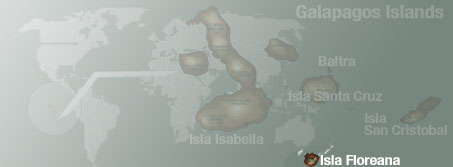ISLA FLOREANA
Isla Floreana is one of the smaller islands in the archipelago, 12km by 15km, and is also one of the oldest. It has a vibrant history and abundant stories of pirates, whalers, convicts and settlers. As it has one of the few reliable sources of fresh water in the islands, it was favoured by settlers. One of those settlers was Frau Wittmer, in 1932, now in her nineties; she still lives there with some of her children, grandchildren and great grandchildren. The family now have a thriving hotel business on the island.

The Floreana race of giant tortoises was extinct by 1846.
Must-sees include post office barrel, in 1792, a barrel was put there by whalers as a primitive post office. Ships would collect the post that was going to the same destination as they were and take it with them, leaving letters of their own for other ships to deliver for them. Even today the tradition of no stamp delivery is still upheld by visitors. They too take other peoples post back to the relevant countries with them.
Not far from the main town, Puerto Velasco Ibarra, at Punta Cormorant, an excellent place to see crabs and sea lions on the coast, are two exceptional and distinct beaches. Green Sand beach, which due to the olivine crystals, seems to have a greenish hint. The mangroves behind this beach hide a salt-water lagoon where you will find flamingos and other wading birds
White Sand beach, because of its fine white sand, formed by the erosion of coral skeletons. This beach is a nesting site for green sea turtles and this can be seen if the weather is warm enough. And from the beach you can see stingrays swimming near the coastline or swim with sharks.
Corona del Diablo (Devil crown) is a half submerged volcanic cone, considered to be one of the most outstanding marine sites of the Galapagos. It is four big rocks, which form something like a crown. The waters are crystalline and warm. There are excellent places to freely snorkel inside and outside of it, with sea lions, a myriad of colourful fish, sharks, and rays, which swim between corals and rocks. And with seabirds having constant skirmishes to use it as a nesting site, it is impossible to explain the bliss you will feel in this incredible paradise.